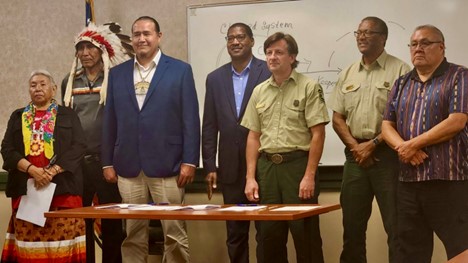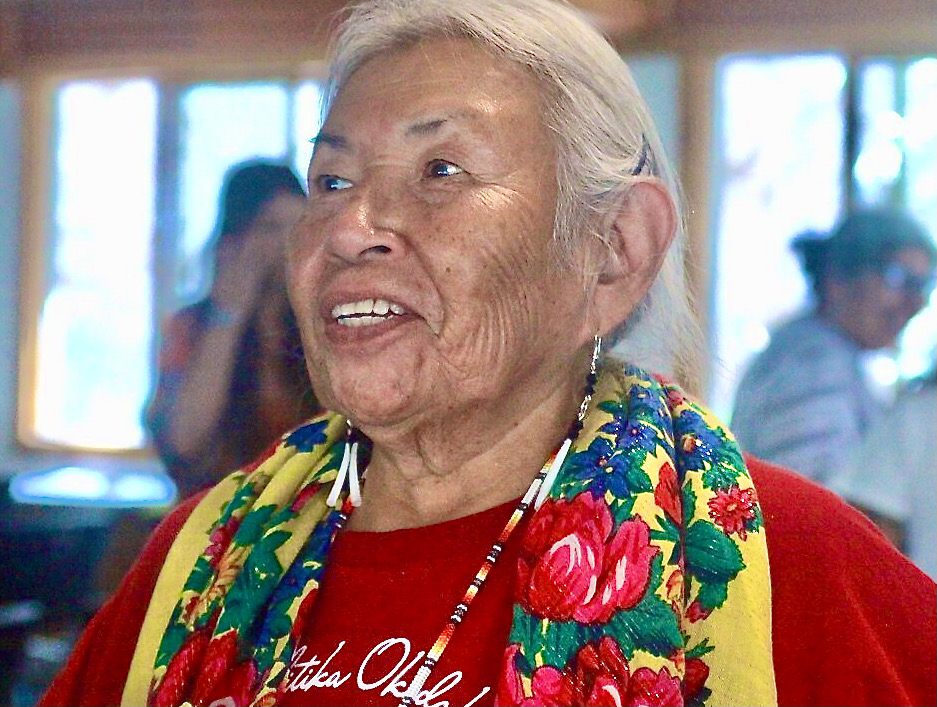Inspired by her grandparents, Tonah Fishinghawk-Chavez proves that caring for the community is an action, not just a word

In Rapid City, South Dakota, on Aug. 22, Arvol Looking Horse signed the Great Sioux Nation and U.S. Forest Service MOU on Black Hills co-stewardship. Accompanying him was Black Hills National Forest Supervisor Shawn Cochran. (Photo credit/ Mark Van Norman)
Great Sioux Nation and Biden Administration representatives opened a path to joint stewardship of the Black Hills National Forest on Aug. 22. The leaders of their respective nations signed a memorandum engaging federal land managers with tribal experts in consultation, planning, and employment on sacred ground.
The U.S. Forest Service, under the Department of Agriculture, supervises 1.2 million acres of the Black Hills, located in South Dakota and Wyoming. The 75-by-120-mile swath of idyllic habitat amidst pine-clad mountains, rivers and streams is a centuries-old sanctuary for many tribes. The Oceti Sakowin, or Seven Council Fires of the Great Sioux Nation, reserved the area as “The Heart of All That Is” with the making of the 1868 Fort Laramie Treaty.
Gold discovery led the United States to break the treaty, violating the U.S. Constitution. Then, in 1980, the Supreme Court ruled that the Lakota-Nakota-Dakota Oyate, or nation, should receive monetary damages for the theft. But the tribes refused, insisting on the return of the land. The recent Memorandum of Understanding acknowledges the Sioux Nation’s claim: “The Black Hills are not for sale.”

Cheyenne River Sioux Tribal Chairman Ryman LeBeau told Buffalo’s Fire he signed the MOU for his elected government “because this land here, this is ours.” His tribal council joins Oceti Sakowin Sioux Nation leaders, elders and spiritual guides in the memorandum over Lakota territory. Time has come “to reclaim our sacred nation,” he said, “to manage, preserve, protect and plant the seeds for the coming generations to reconnect with He Sapa, Black Hills.”
The document is based on a federal template for MOUs. The directive’s title defines the intent: “Collaboration with the Great Sioux Nation Tribes in Relation to Forestry Planning, Healthy Forest, Workforce Development and Stewardship in the Black Hills National Forest.” In it, the tribes stipulated that their cooperation waives no treaty rights.
Eight Sioux tribal governments signed on, which put the process in place for the next five years: Cheyenne River, Crow Creek, Lower Brule, Oglala, Spirit Lake, Sisseton-Wahpeton, and Standing Rock. After an amendment and discussion with elders at the signing ceremony in Rapid City, S.D., Arvol Looking Horse blessed the paperwork with a Lakota ceremonial smudge of smoke. The document remains open for other Sioux Nation signatories including the Yankton, Santee and Flandreau tribes.
“This land here, this is ours. It’s time to reclaim our sacred nation, to manage, preserve, protect and plant the seeds for the coming generations to reconnect with He Sapa, Black Hills.”
Ryman LeBeau, Cheyenne River Sioux Tribal Chairman
Faith Spotted Eagle, a citizen of the Yankton Sioux Tribe, attended the ceremony on behalf of her traditional Braveheart Society. She said her tribe’s General Council must approve the memorandum before signing.
She and Looking Horse obtained an amendment to the MOU to assert “our teachings are based on natural law,” she told Buffalo’s Fire. “The white people call (the Black Hills) a cultural landscape. We need to have the feds recognize that as a sacred site,” she said. Looking Horse, a Mniconjou Lakota, is the 19th-generation Sioux Nation’s Sacred White Buffalo Calf Pipe Bundle keeper.
Across the country, the Forest Service has entered into 180 similar stewardship accords with tribes. The non-binding “handshake” agreements establish frameworks for agency cooperation with the ancestral land heirs.
In Rapid City, tribal government signatories determined they would choose a new top-level position: the Great Sioux Nation Black Hills National Forest Stewardship Director. According to the memo, the administrator will “act on their behalf to promote the effective implementation” of the memo and its pursuant action.

They will use Public Law 93-638, the Indian Self-Determination and Education Assistance Act, which established tribes’ authority to contract with the federal government and agencies such as the Forest Service to operate programs and services.
“The MOU opens the doors for future ‘638’ contracts like tribes already have with federal agencies like BIA and IHS,” LeBeau said. It “also helps secure funding to put tribal members, youth and adults, to work doing the co-stewardship of the Forest Service.” The memorandum fosters “creating new projects that the tribes want to build and manage,” LeBeau said.
That includes tribal youth culture camps, similar to the Forest Service’s existing Boxelder Job Corps training. It “provides the tribes a unique opportunity in decisions that affect the health of the forest,” LeBeau said. “We can implement traditional Lakota ecological practices.”
The MOU is the result of myriad sustained efforts over many years. LeBeau has urged the Sioux Nation tribes to redouble efforts to secure greater Forest Service cooperation. His predecessor, former Cheyenne River Chairman Harold Frazier, also backed the project. Oglala Sioux President Frank Star Comes Out, Rosebud Sioux President Scott Herman, and others also promoted increased collaboration to protect the Black Hills for the youth today and “for the next seven generations and beyond,” as stated in the document.
“We are working to protect the Black Hills for the youth today and ‘for the next seven generations and beyond.’”
Frank Star Comes Out, Oglala Sioux Tribal President
“When I was on the Treaty Council 25 years ago, we asked the Forest Service to do these things, but they did nothing,” said Standing Rock Sioux Tribal Council Representative Jeff Cadotte. “Now that the Forest Service is ready, it’s time for us to move forward.”
Like other decision makers in Indian Country, they took to heart U.S. President Joe Biden’s policies for strengthening Native nation-to-nation relations and treaty rights. His formal executive decrees to boost tribal sovereignty were among the factors in achieving the MOU status needed for federal fiscal 2025 consideration this October.
Reed Robinson, USDA Forest Service director of Tribal Relations, was unavailable for comment. “Two years ago, we met with USDA Under Secretary Homer Wilkes and Chief Forester Randy Moore at Rapid City. We stressed the importance of developing an MOU to co-steward the Black Hills,” LeBeau said.
“They were very open and understanding our desire to get tribes reconnected and access to the Black Hills. We thank them and the Black Hills Forest Supervisor and staff for honoring this commitment.” In Lakota, he added, many thanks to all: Wopila ichchiyapelo.Oglala Sioux Tribal President Frank Star Comes Out obtained an Executive Committee resolution backing the memorandum. Tribal lawyer Mario Gonzalez, a citizen of the Oglala Sioux Tribe, called the signing ceremony “important.” Gonzalez filed the injunction that stopped the payment of the 1980 Black Hills award, initially to his tribe and ultimately to all the rest, securing their enduring claim to the land.
Talli Nauman
Contributing Editor
Location: Spearfish, South Dakota
Spoken Languages: English, Spanish
Topic Expertise: Climate, Environmental and Social Justice; Right to know; Spearfish, South Dakota
See the journalist pageFS Agreement No. 24-MU-11020300-045 Memorandum of Understanding “Collaboration with the Great Sioux Nation Tribes in Relation to Forestry Planning, Healthy Forest, Workforce Development and Stewardship in the Black Hills National Forest”
Resolution No. 24-56XB “Resolution of the Executive Committee Of the Oglala Sioux Tribe
Press Release Aug. 22 “Oglala Sioux Tribe Joins Sister Great Sioux Nation Tribes to Sign MOU for Framework for Co-Stewardship Activities in the Black Hills National Forest
© Buffalo's Fire. All rights reserved.
This article is not included in our Story Share & Care selection.The content may only be reproduced with permission from the Indigenous Media Freedom Alliance. Please see our content sharing guidelines.
The billboard project is expanding to Oregon
Identification not yet made
Indigenous participation may be highest in the climate conference’s history
At an oak savannah near Eugene, Oregon, TEIP interns and elders carry forward a time-honored tradition, restoring meadow health and renewing relationship with the land
UTTC International Powwow attendees share their rules for a fun and considerate event







